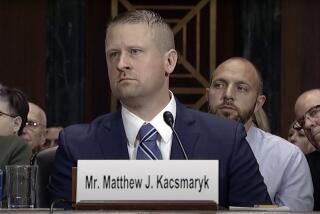A crime against motherhood
- Share via
My mom’s first day of motherhood was one of the happiest of her life. It was also one of the worst.
She had accompanied my dad from Sri Lanka to Washington State University in 1968, so he could complete his doctorate as a Fulbright Scholar. The school was in Pullman, a small town near the Idaho border. Fluent in English, she worked as a university librarian.
During her pregnancy, at age 30, she received care from one of Pullman’s few obstetricians. She endured labor without drugs, and I was born healthy in 1972. Because fathers weren’t allowed in the maternity ward overnight, my dad went back to their apartment when I was a few hours old.
As soon as he left, the doctor cut out my mom’s uterus.
He didn’t ask permission to perform the hysterectomy. In fact, he ignored her pleas. “There are too many colored babies already,” he told her. Exhausted from labor, my mom was too weak to resist as she was wheeled into the operating room and put under anesthesia. On her medical record, the doctor wrote “exploratory” as the reason for the operation. The real reason, of course, was eugenics, the racist pseudoscience of human breeding.
My mom was not alone in her anguish. According to historian Mark Largent, more than 63,000 people were forcibly sterilized under eugenics-inspired official state programs in the U.S. between 1907 and 1980. Roughly one-third of them were sterilized in California. My mom was among the uncounted others who were coercively sterilized by overzealous private doctors acting on their own. Medical privacy laws make it hard to learn how many were victimized this way.
It was a horrifying exercise in genetic engineering. The intent was to strengthen the gene pool and reduce welfare rolls. The victims were usually women, including African Americans, Asians, Jews, Latinos, Native Americans, alcoholics, the disabled, epileptics, illiterates, the mentally ill, petty criminals, the poor, the promiscuous, rape victims and “anyone else who did not resemble the blond and blue-eyed Nordic ideal the eugenics movement glorified,” as Edwin Black noted in his book “War Against the Weak.”
When my dad returned to the hospital the next morning, my mom was irreversibly sterile. Growing up, I wondered why I was an only child. As I headed off to college, she finally told me what had happened. I found out later exactly how a racist doctor could do this to a woman in modern America.
The word “eugenics” was coined in 1883 by a British scientist, Francis Galton, who was Charles Darwin’s half-cousin. In the U.S. the movement was championed by wealthy elites like John Harvey Kellogg, doctor, corn flakes magnate and creator of the Race Betterment Foundation in Battle Creek, Mich. The Nazis relied on eugenics research financed by the Carnegie Institution and the Rockefeller Foundation.
The state of Washington, where my mom was victimized, enacted forced sterilization laws in 1909 and 1921. The 1909 law, which allows for involuntary sterilization of molesters, rapists and habitual criminals, remains on the books. The broader 1921 statute aimed to “prevent the procreation of feeble-minded, insane, epileptic, habitual criminals, moral degenerates and sexual perverts.” It was overturned by the Washington State Supreme Court in 1942.
The U.S. Supreme Court upheld forced sterilization in 1927, a decision that still stands. Justice Oliver Wendell Holmes wrote in the majority decision, “It is better for all the world, if instead of waiting to execute degenerate offspring for crime, or to let them starve for their imbecility, society can prevent those who are manifestly unfit from continuing their kind.... Three generations of imbeciles are enough.” At the Nuremberg trials, Nazis quoted Holmes in their defense.
My parents never reported the crime against my mother. They never sued the physician. They worried about how the police would react and were scared of retaliation by the doctor. Since they were here on visas and not yet U.S. citizens, they also feared being deported. And I think my (late) dad was ashamed that such a thing had happened to his wife.
Five years later, we moved to Palo Alto, where two public schools are named after eugenicists: the first Stanford University president, David Starr Jordan, and Stanford professor (and co-inventor of the Stanford-Binet IQ test) Louis Madison Terman. They were both members of the Pasadena-based Human Betterment Foundation that promoted compulsory sterilization legislation across the United States.
The recognition that so many people were systematically wronged has been slow in coming. Law professor Paul A. Lombardo has found that just seven of the 32 states with official sterilization programs have apologized to their victims: Virginia (2001), Oregon (2002), North Carolina (2002), South Carolina (2003), California (2003), Georgia (2007) and Indiana (2007). (Two states do not appear to have officially sterilized people before their compulsory sterilization laws were removed: New Jersey and Nevada.)
Only North Carolina has gone further. Earlier this year, a task force recommended a lump-sum payment of $50,000 to each victim still living: 2,000 of 7,600. The state also set up a counseling service and a traveling exhibit on eugenics.
Much more must be done. The other 23 states that practiced eugenics -- Alabama, Arizona, Connecticut, Delaware, Idaho, Iowa, Kansas, Maine, Michigan, Minnesota, Mississippi, Montana, Nebraska, New Hampshire, New York, North Dakota, Oklahoma, South Dakota, Utah, Vermont, Washington, West Virginia and Wisconsin -- must apologize and offer compensation to their victims.
We must examine the role of private doctors in forced sterilization to ensure the practice has indeed stopped. Most important, we must outlaw forced sterilization in the United States.
None of this will give my mother another child to hug this Mother’s Day. But admitting the wrong done would help heal our family -- and our country.
More to Read
Sign up for Essential California
The most important California stories and recommendations in your inbox every morning.
You may occasionally receive promotional content from the Los Angeles Times.










